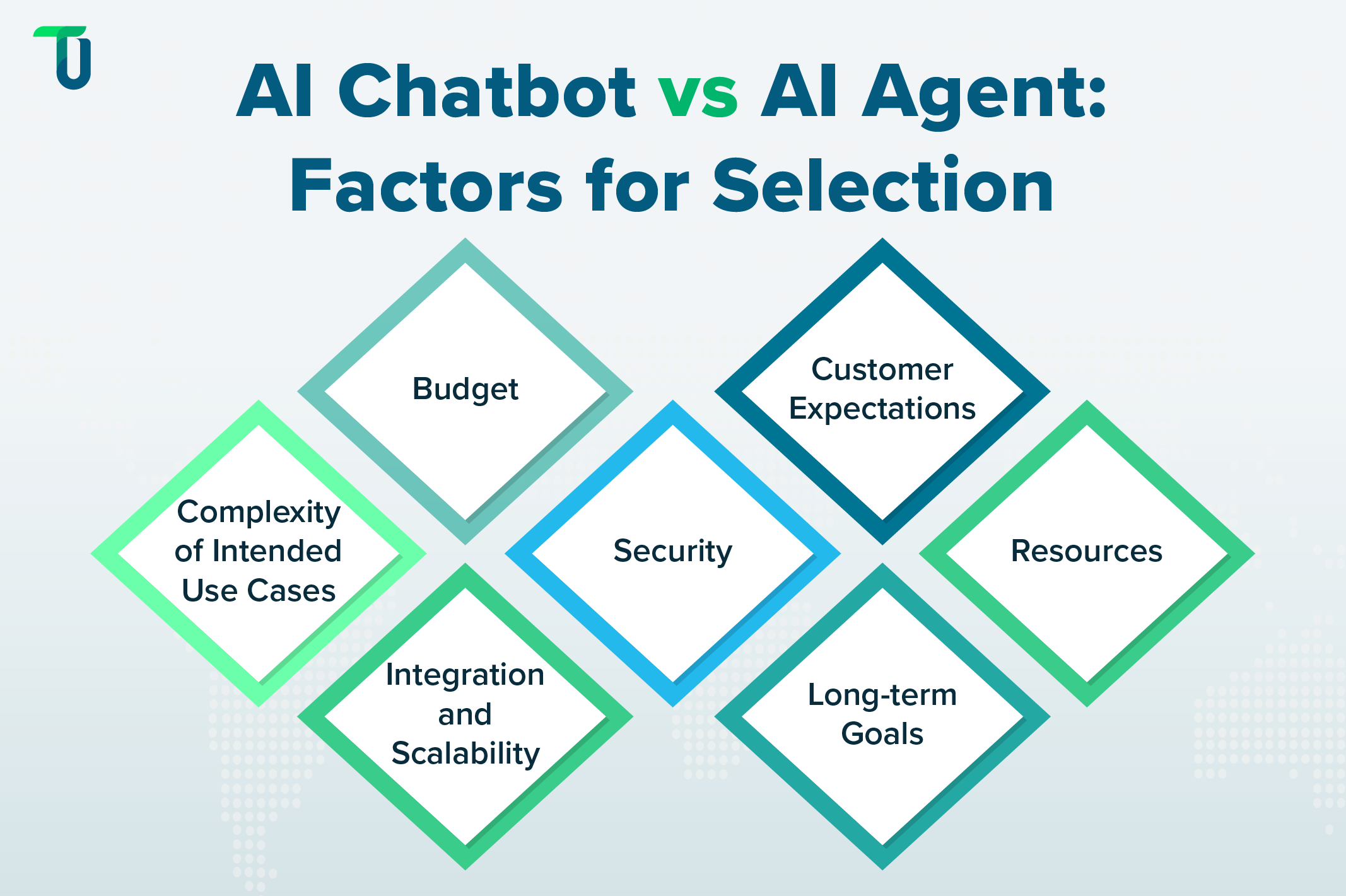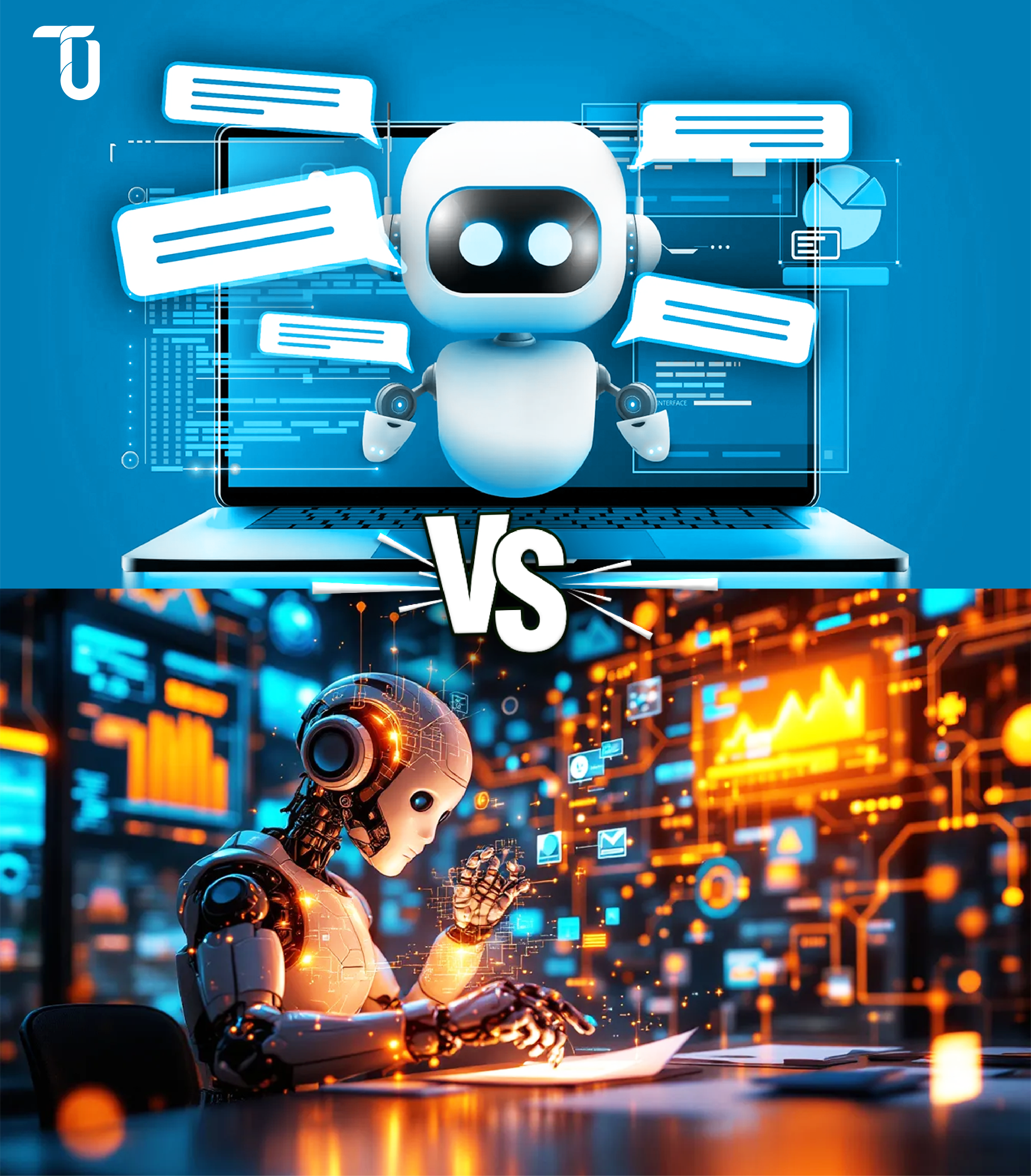AI Chatbots and AI Agents Explained
AI chatbots use natural language processing (NLP) and machine learning (ML) to understand user queries in human language and respond in a human-like conversational manner. These chatbots can work with image, video, audio, and code format data as well. Hybrid chatbots take user experience to the next level by providing comprehensive features. Chat GPT, Facebook Messenger Bots, and Rose are popular examples of AI chatbots
Depending on their intended use cases, the chatbots could be built using techniques like pre-programmed responses, machine learning algorithms, and even AI-powered context management. Key applications of AI chatbots include handling conversations and automating simple tasks like tracking orders, booking appointments, providing recommendations, etc. With fine-tuning using niche data, AI chatbots handle many domain-specific tasks across industries like e-commerce, banking, healthcare, travel, etc. They provide benefits like 24/7 availability, cost-efficiency, and automation of repetitive tasks to businesses.
AI agents are more advanced systems than AI chatbots because they go beyond conversation and simple automation. They have multitasking abilities as they can seamlessly switch between tasks and maintain context. This helps them handle complex interactions more efficiently. AI agents can use real-time data to ground their actions and provide deeper conversations. So, they can offer more personalized and relevant responses compared to chatbots, which rely mainly on predefined models.
AI agents are built to take autonomous actions based on data and user behavior, allowing them to make decisions and execute tasks like AI agents in purchase order automation, processing payments, or rescheduling bookings. This capability enables businesses to automate complex workflows, handle challenging customer interactions, and deliver highly personalized experiences.
Agentic AI-based workflows are used for applications where systems must act proactively, such as self-driving vehicles, smart home solutions, and virtual assistants requiring real-time decision-making. For instance, if you have a pre-booked taxi after a meeting and your meeting gets delayed, your AI agent-based virtual assistant proactively asks if the taxi booking needs to be delayed and completes the task upon your confirmation. Some popular examples of virtual assistants using AI agents include Siri, Alexa, and Google Assistant.
Lately, hybrid systems, where AI chatbots and Agentic AI work together, are increasingly being developed. For example, the chatbot might handle initial queries and escalate to an AI agent for deeper problem-solving. This blending of strengths offers seamless user experiences.
Similarities between AI chatbots and AI agents
While AI chatbots and AI agents have distinct roles, they share several similarities that make them part of the broader AI ecosystem. They include:
Foundation in AI: Both rely on NLP and ML to understand and process human language and offer intelligent solutions. Whether an AI chatbot answers “What’s my order status?” or an AI agent books a meeting, both use NLP and ML.
Enhancing User Experience: They streamline interactions and make tasks faster and more intuitive for users through conversation, automation, or both. While an AI chatbot provides quick customer support, an AI agent automates end-to-end workflow, reducing user effort.
Conversational Interface: They often interact with users via text or voice, offering a conversational entry point, even if their depth of interaction differs. Both might start with “How can I help you?
Data Dependency: Data drives the responses of both AI-based chatbots and AI agents. For instance, a chatbot might pull information from an FAQ database, and an agent might fetch data from integrated systems or real-time sources.
Need to develop AI-based solutions?
Leverage our capabilities in Gen AI, Vision AI, ML, and NLP to build custom solutions for your business needs.
Differentiating Factors Between AI Chatbots and AI Agents
Even with many similarities, the core of AI chatbots and AI agents is different as they are built to accomplish varied purposes and have varied capabilities. However, with AI chatbots getting more sophisticated and AI agents becoming more conversational, the differentiating line between them gets thinner, leading to confusion. Here are some of their differentiating factors that will help avoid the confusion between the terms:
Task Complexity: Modern AI chatbots are not just limited to answering FAQs and automating simple tasks; they can handle guided multi-step tasks like troubleshooting. However, they struggle with complex, unscripted tasks requiring dynamic decision-making.
AI agents can solve unstructured problems like planning a project, coordinate actions across multiple systems like syncing data between GitHub and Slack, or automating enterprise workflows powered by AI integration with ERP and CRM systems.
Autonomy: The latest Generative AI models have made chatbots more dynamic, enabling contextually appropriate responses and fluid conversations. They can perform scripted actions triggered by user input and adjust responses within a session, but true autonomy, like initiating actions or real-time adaptation, remains limited.
Agentic AI, however, takes autonomy to the next level. AI agents can proactively initiate actions, make decisions, and execute complex, multi-step processes without human intervention.
Learning and Adaptation: Some advanced AI chatbots use machine learning to improve over time. They adapt through periodic updates, using user feedback and interaction data to understand user needs better and deliver more relevant responses.
AI agents use adaptive models that adjust within sessions and utilize techniques like reinforcement learning and transfer learning to improve their performance over time. They learn from past experiences and use this knowledge to handle unfamiliar scenarios while adjusting their approach based on user feedback.
Scope of Knowledge: AI Chatbots are now far more versatile than their older counterparts. They access a broader range of knowledge through integrations with real-time databases, APIs, and cloud systems, enabling more relevant, dynamic responses to handle complex queries and guided workflows.
AI agents go beyond just accessing information. They combine and synthesize data from various sources, reasoning across domains and making logical inferences. With deeper context understanding and broader knowledge bases, AI agents handle tasks like cross-platform coordination, strategic decision-making, and dynamic problem-solving.
Multi-modal Communication: Traditional chatbots relied on text-based communication. An AI chatbot with multimodal capabilities can not just handle text but also voice commands and process visual inputs like images or videos. This helps them interact more naturally with users and offers automation solutions.
AI Agents go one step further with advanced multi-modal communication. They can process and respond across text, voice, images, and even videos, seamlessly adapting to the user’s preferred channel. Whether it is voice-based customer support or analyzing a video request to troubleshoot an issue, AI agents deliver a more versatile and fluid interaction experience, making them ideal for dynamic, multi-channel engagement.
Use Cases: AI chatbots are best suited for high-volume, repetitive, and simple tasks like:
- Answering FAQs
- Handling basic customer inquiries
- Scheduling appointments.
- Assisting with website navigation
On the other hand, AI agents are increasingly used for more complex applications like:
- Solving intricate customer problems
- Providing personalized assistance
- Automating business processes
- Conducting data analysis
- Supporting strategic decision-making
| Factors | AI Chatbots | AI Agents |
|---|---|---|
| Task Complexity | Simple, repetitive queries | Complex, multi-step tasks & workflows |
| Autonomy | Follows predefined scripts | Makes autonomous decisions, initiates actions independently |
| Learning & Adaptation | Learns from user interactions over time, with manual updates | Improves over time based on user feedback and data |
| Scope of Knowledge | Limited to pre-set knowledge & integration | Synthesizes data from various sources, makes logical inferences |
| Multi-Modal Communication | Primarily text-based, can handle voice and images in some cases | Supports text, voice, images, and video |
| Personalization | Basic responses based on predefined context | Personalized, context-aware interactions |
| Integration & Scalability | Limited; best for single-platform tasks | Highly scalable; integrates across multiple systems |
| Real-Time Decision Making | Limited | Proactive decision-making |
| User Interaction | Quick, simple interactions | Deep, meaningful conversations |
| Security | Easier to secure & audit | Needs robust security |
How to Choose Between AI Chatbot and AI Agent for Your Business
While AI agents are clearly more advanced than AI chatbots, both serve different purposes and offer distinct advantages. Consider the nature of your business, the complexity of tasks you want to automate, and your long-term goals to make an informed decision. These critical consideration factors can help you choose the right solution:

Complexity of Intended Use Cases: Choose an AI chatbot if your intended use cases involve simple, repetitive tasks like answering FAQs or scheduling appointments. However, for complex, multi-step unguided workflows or multi-system workflows, an AI agent will be more suitable.
Budget: When working with a limited budget, it is advisable to opt for an AI chatbot as it is more affordable to implement and maintain. Even so, if you aim for long-term savings and don’t mind higher initial costs, go for an AI agent. AI agents will automate complex tasks and improve productivity to deliver lower operating costs in the long run.
Integration and Scalability: If your business is growing and you need a flexible solution that adapts to various environments, choose AI agents. Contrarily, if your intended use cases are limited to a single platform or fewer systems, implementing an AI chatbot and integrating it with required systems will be a better option.
Security: If your business handles sensitive information, ensuring data privacy and compliance should be your top priority, whether you decide to use AI chatbots or Agentic AI. With their narrower focus, chatbots are easier to secure and audit. Whereas, AI agents, due to their broader access to systems and data, require more robust security measures.
Customer Expectations: Chatbots are ideal if your customers mainly need quick answers to simple questions. But if they expect personalized, in-depth assistance, an AI agent can provide that level of understanding and adapt to each customer’s needs.
Long-term Goals: Investing in AI agents is better if you plan to scale and require more advanced customer service capabilities. While chatbots are great for basic tasks, AI agents offer more flexibility and continuous learning, which helps them adapt as your business grows.
Resources: Teams with limited AI skills can build and maintain AI chatbots. But for AI agents, you will need AI experts with specialized knowledge and experience in developing systems using AI agents.
Check out our case study, where we used multiple AI agents to build a purchase order automation system for a manufacturing industry client.
AI Chatbots vs AI Agents: Build a Custom Software Solution
Now that you’ve learned about AI chatbots and AI agents including their similarities, differences, and when to use them, we hope that you can make informed decisions. Basically, you need AI-based solutions that align with your automation requirements, match your time and cost constraints, and deliver tangible results. If you’re still confused with your AI development strategy, consider consulting AI experts.
Our team of experts has built several AI-powered solutions customized to our clients' specific business needs across multiple industries, utilizing our capabilities in Gen AI, Vision AI, ML, and NLP. We take pride in understanding our clients’ challenges and designing personalized solutions to overcome them.
Need help choosing the right AI solution?
Our AI experts will design a personalized AI strategy for your business after understanding your needs, goals, and existing IT infrastructure.
Frequently asked questions
What is the difference between an AI chatbot and an AI agent?
AI chatbots are designed for simple, rule-based interactions, typically handling FAQs and structured conversations. AI agents, on the other hand, can analyze context, learn from interactions, make decisions, and perform complex tasks autonomously.
When should I use an AI chatbot instead of an AI agent?
If your goal is to automate repetitive, structured interactions like customer support or lead qualification, a chatbot is ideal. AI agents are better for tasks requiring decision-making, adaptability, or multi-step workflows, such as personalized customer assistance or business automation.
What are examples of AI agents in real life?
AI agents are widely used in
- Customer Service: Virtual assistants like Siri, Google Assistant, and AI-driven chatbots.
- Healthcare: AI-powered diagnostics, remote patient monitoring, and medical chatbots.
- Finance: Algorithmic trading, fraud detection, and financial advisory bots.
- Marketing: AI-driven recommendations, campaign automation, and lead scoring.
How do AI agents learn and improve over time?
AI agents use machine learning, natural language processing (NLP), and historical data to refine their decision-making. They analyze past interactions, identify patterns, and improve responses over time, making them smarter and more efficient.
Are AI agents more expensive to build than chatbots?
Yes, AI agents require sophisticated technologies such as deep learning, data analytics, and real-time processing, making them more complex and costly to develop and maintain compared to simpler rule-based chatbots.
Do AI agents need human supervision?
While AI agents can function independently, human supervision is essential for quality control, ethical considerations, and refining decision-making. Businesses must monitor AI behavior to prevent biases and ensure alignment with company goals.
Can I combine AI chatbots and agents in one system?
Yes, combining both enhances efficiency. AI chatbots handle simple queries, while AI agents manage complex interactions, enabling a seamless experience. Many companies integrate both for better automation and personalized customer engagement.

